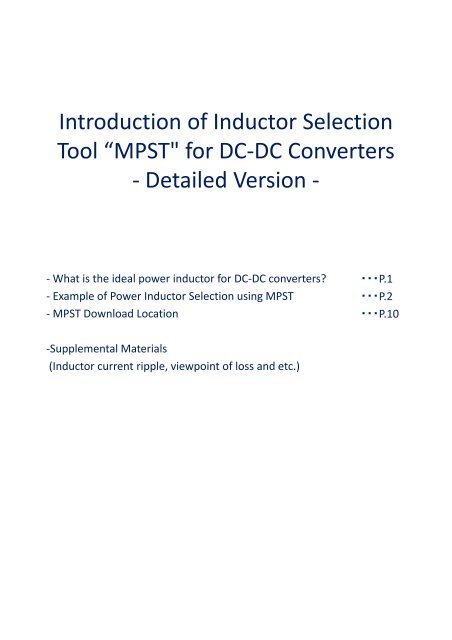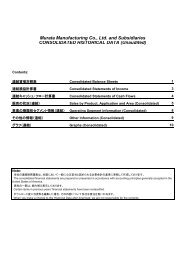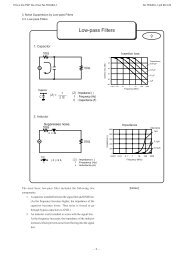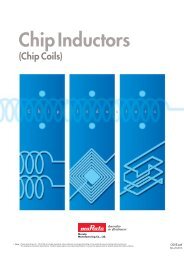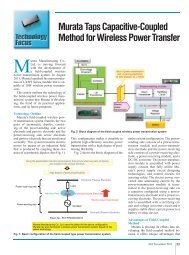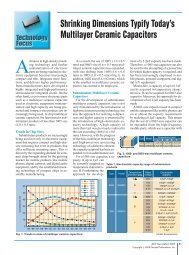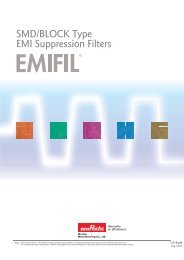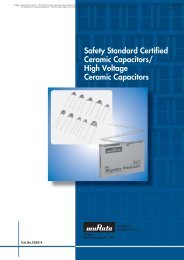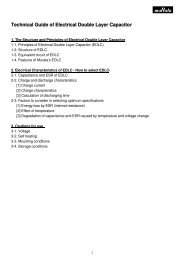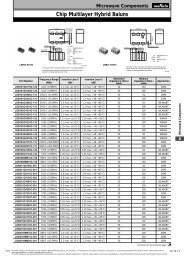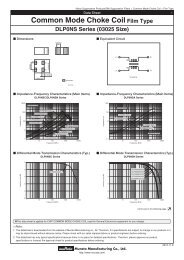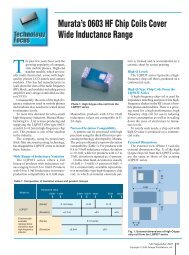Introduction of the DC-DC Converter Inductor Selection Tool - Murata
Introduction of the DC-DC Converter Inductor Selection Tool - Murata
Introduction of the DC-DC Converter Inductor Selection Tool - Murata
Create successful ePaper yourself
Turn your PDF publications into a flip-book with our unique Google optimized e-Paper software.
Having trouble selecting power inductorswhen designing <strong>DC</strong>-<strong>DC</strong> converter circuits?First <strong>of</strong> all, what is <strong>the</strong> "ideal" power inductor?<strong>Inductor</strong>s having <strong>the</strong> following conditions can be called <strong>the</strong> ideal inductor.- Low loss in <strong>the</strong> target load range- Having an inductance value with balanced load response and ripple- Having sufficient bias current characteristics and rated current for <strong>the</strong> assumed current- Designable sizeHowever, <strong>the</strong> "target load range ", "point <strong>of</strong> load response and ripple balance", "current margin","designable size" and etc. change according to <strong>the</strong> application and <strong>the</strong> design concept <strong>of</strong> <strong>the</strong>designer.In short, <strong>the</strong> "ideal" power inductor changes with various conditions and requirements.The <strong>Murata</strong> Power <strong>Inductor</strong> <strong>Selection</strong> <strong>Tool</strong> (MPST) is a tool to support <strong>the</strong> process<strong>of</strong> selecting an ideal power inductor in consideration <strong>of</strong> <strong>the</strong>se complex factors.
Example <strong>of</strong> Power <strong>Inductor</strong> <strong>Selection</strong> using MPST* Following shows one exampleAssuming a case where a 2.5 x 2.0 x 1.0 mm size conductor is selected for a step‐down <strong>DC</strong>‐<strong>DC</strong> converterfor a portable device with 6 MHz operating frequency, 3.6 V input voltage, 1.8 V output voltage and 0.6A max output current* Condition focusing on <strong>the</strong> efficiency at a high load, with an allowable ripple to some extent.1 st stepInputting <strong>the</strong> Conditions and SearchingSelect "Simple Search", input <strong>the</strong> desired conditions <strong>the</strong>n click "Search" to start <strong>the</strong> search.•Type1:Buck•Type2:PFM/PWM•Switching Frequency : 6000 [kHz]•Max Input Voltage: 3.6 [V]•Min Input Voltage: 2[V]•Output Voltage: 1.8 [V]•Output Current: 0.6 [A]•<strong>Inductor</strong> Current Ripple (Want):30%(Max):70%•Size:Body Height min:1[mm]Body Height eg max:1[mm]Bottom Area min:5[mm]Bottom Area max:5[mm]TopicsThis tool supports Buck, Boost and Inverting Buck‐Boost.The PFM/PWM automatic switching function can also be simulated.By specifying <strong>the</strong> inductor current ripple, <strong>the</strong> inductance value when <strong>the</strong> inductor current ripplebecomes <strong>the</strong> ideal value (want) and <strong>the</strong> Min/Max <strong>of</strong> <strong>the</strong> allowable value, will be calculatedautomatically and reflected in <strong>the</strong> results.* When a value is input in Min/Max, <strong>the</strong> output results can be sorted to only <strong>the</strong> components which satisfy <strong>the</strong>inductor current ripple within <strong>the</strong> Min/Max value.‐ The results can be sorted to only <strong>the</strong> inductors with <strong>the</strong> desired (want) conditions.* Allowable sorting conditions: Size, inductance value, Rdc, rated current, part number
2 nd stepConfirming <strong>the</strong> Output Results<strong>Murata</strong>'s power inductors suitable to <strong>the</strong> conditions will be displayed in order from <strong>the</strong> lowest to <strong>the</strong>highest loss (Total Loss).Low LossTopics* The value when <strong>the</strong> highest load is applied to <strong>the</strong> inductor with <strong>the</strong> input conditions will be displayed.An evaluation can be performed individually for <strong>the</strong> core loss and conductor loss. Theevaluation <strong>of</strong> <strong>the</strong> loss which was conventionally predicted only as an estimate from <strong>the</strong> <strong>DC</strong>resistance can now be accurately evaluated.* Click here for more details on <strong>the</strong> viewpoint <strong>of</strong> power inductor loss.Example:The overall loss may become lower with a larger <strong>DC</strong> resistance in some cases.The values can be seen on <strong>the</strong> MPST screen without performing an actual evaluation.The inductance value in an actual use state will be displayed.Until now, <strong>the</strong> inductance value in an actual use state (current decreased due to <strong>the</strong> bias) couldonly be predicted from <strong>the</strong> bias current characteristics.Since <strong>the</strong> MPST simulation displays <strong>the</strong> values considering <strong>the</strong> frequency and current amplitudenot only <strong>the</strong> <strong>DC</strong> component <strong>of</strong> <strong>the</strong> current, more accurate values can be understood.The inductor current ripple can be evaluated.This evaluation allows <strong>the</strong> selection <strong>of</strong> inductors from <strong>the</strong> viewpoint <strong>of</strong> <strong>the</strong> ripple voltage and <strong>the</strong>load response characteristics, not only from <strong>the</strong> viewpoint <strong>of</strong> <strong>the</strong> efficiency.Rl Relationship between <strong>Inductor</strong> Current Ripple and Stability & Fast ResponseRipple VoltageFast Response(Load Response Characteristics)<strong>Inductor</strong> current ripple High High Good<strong>Inductor</strong> current ripple Low Low Poor
3 rd stepConfirming <strong>the</strong> Detailed DataWhen <strong>the</strong> "Detailed Data" button on <strong>the</strong> right end <strong>of</strong> <strong>the</strong> column is clicked, a detailed data sheet will bedisplayed for each inductor.Detailed data screen <strong>of</strong> each componentThe data required to select inductors, from <strong>the</strong> basic catalog specifications to graphsThe data required to select inductors, from <strong>the</strong> basic catalog specifications to graphs<strong>of</strong> <strong>the</strong> characteristic fluctuations assuming actual use, will be displayed collectively inone sheet.
■Current Wave formComparison between MPST Output Results andMeasurement Results using <strong>DC</strong>‐<strong>DC</strong> <strong>Converter</strong> Evaluation KitMeasurement resultsMPST output resultsCurrent waveform flows to an inductor underset conditionsResults extremely close to a measurementcan be acquired.■<strong>DC</strong> Current – Inductance CharacteristicsChange <strong>of</strong> <strong>the</strong> inductance value when onlychanging <strong>the</strong> <strong>DC</strong> component <strong>of</strong> <strong>the</strong> currentwithout changing <strong>the</strong> current amplitudeThis graph shows <strong>the</strong> change <strong>of</strong> <strong>the</strong>inductance value when <strong>the</strong> triangular wave<strong>of</strong> <strong>the</strong> current waveform is moved up anddown in parallel.* The value becomes almost equivalent to<strong>the</strong> bias current characteristics.
■Output Current – Inductance CharacteristicsL value <strong>Inductor</strong> complying current with Rippleの <strong>the</strong> Want settingvalue <strong>of</strong> Want inductor 設 定 値 current に 対 応 ripple するL 値L <strong>Inductor</strong> value complying current RippleのMax with <strong>the</strong> Max settingvalue 設 定 値 <strong>of</strong> に inductor 対 応 するL current 値 rippleChange <strong>of</strong> <strong>the</strong> inductance value when <strong>the</strong>output current is changedWhen <strong>the</strong> output current is changed, <strong>the</strong> currentamplitude will also change.The characteristics in consideration <strong>of</strong> thischange are displayed in this graph.Changes <strong>of</strong> <strong>the</strong> inductance value closer to actualconditions than <strong>the</strong> simple bias current can beevaluated.Example: Changes <strong>of</strong> <strong>the</strong> current amplitudeby changing <strong>the</strong> output current@LQM2HPN1R0MG0Output Current [A]Current Amplitude [A]0.6 0.1961.0 0.4521.4 0.522■Output Current –Loss CharacteristicsChanges <strong>of</strong> loss from high load to low loadcan be evaluated.The current (transition current) which changesfrom PFM to PWM can also be estimated.Changes <strong>of</strong> loss when <strong>the</strong> output current <strong>of</strong><strong>the</strong> <strong>DC</strong>‐<strong>DC</strong> converter is changedTransition Current
■Frequency –Loss CharacteristicsWhen <strong>the</strong> switching frequency is changed, <strong>the</strong>current waveform will change greatly. Thecharacteristics in consideration <strong>of</strong> this changeare displayed in this graph.This can be used as a reference when <strong>the</strong> ICoperating frequency has not beenestablished.Changes <strong>of</strong> loss when <strong>the</strong> switching <strong>of</strong>a <strong>DC</strong>‐<strong>DC</strong> converter is changedCurrent [A]Change <strong>of</strong> Waveformby スイッチング Changing <strong>of</strong> 周 Switching 波 数 の 変 Frequency 化 による 波 形 の 変 化09 0.90.80.70.60.50.40.30.201 0.100 0.2 0.4 0.6 0.8 1 1.2Time[us]■Input Voltage –Loss CharacteristicsThis graph shows <strong>the</strong> change <strong>of</strong> loss when<strong>the</strong> input voltage <strong>of</strong> a <strong>DC</strong>‐<strong>DC</strong> converter ischanged.The following cases are assumed for <strong>the</strong>evaluation.When designing i portable tbl devices:Evaluation <strong>of</strong> loss when <strong>the</strong> voltagedeteriorates by consumption <strong>of</strong> a batteryChanges <strong>of</strong> loss when <strong>the</strong> input voltage <strong>of</strong>a <strong>DC</strong>‐<strong>DC</strong> converter is changed(For IC designers)When setting <strong>the</strong> reference component <strong>of</strong>a <strong>DC</strong>‐<strong>DC</strong> converter IC:Evaluation <strong>of</strong> an inductor ideal for <strong>the</strong>overall input voltage within <strong>the</strong>specification range
4 th stepComparing <strong>the</strong> Detailed DataWhen a check mark is entered in <strong>the</strong> check box on <strong>the</strong> right side end <strong>of</strong> <strong>the</strong> inductor and <strong>the</strong>"Compare" button is clicked to select <strong>the</strong> characteristic items to be compared, <strong>the</strong> comparison sheet <strong>of</strong><strong>the</strong> detailed data will be displayed.The above graph shows that LQM2HPN1R0MG0 is <strong>the</strong> most suitable inductor in this example.Point!‐ Even when a current beyond <strong>the</strong> output current flows, <strong>the</strong>re is a margin to <strong>the</strong> limit i <strong>of</strong> <strong>the</strong>inductance value.‐ Loss at a high load is superior compared to <strong>the</strong> o<strong>the</strong>r two candidates.‐ Even when <strong>the</strong> input voltage deteriorates, <strong>the</strong> loss remains <strong>the</strong> lowest.* The conclusion changes depending on various conditions, such as when <strong>the</strong>efficiency is focused on at a low load, or when <strong>the</strong> ripple must be suppressed.
The ideal power inductor can be selectedby comparing <strong>the</strong> detailed data from various points <strong>of</strong> view.
MPST Download LocationDownload MPST from <strong>the</strong> "Design Support <strong>Tool</strong>" page <strong>of</strong> <strong>Murata</strong>'s Web site.MPST (<strong>Murata</strong> Power <strong>Inductor</strong> <strong>Selection</strong> <strong>Tool</strong>) download page:http://www.murata.com/products/design_support/mpst/index.html* MPST is a VBA application (Macro) which operates in Micros<strong>of</strong>t Excel.Micros<strong>of</strong>t® Excel® 2003 or later is required to execute MPST.In order to execute MPST, it is necessary to validate <strong>the</strong> execution <strong>of</strong> <strong>the</strong> Macro in Micros<strong>of</strong>t® Excel®. For <strong>the</strong>method <strong>of</strong> validating <strong>the</strong> Macro, refer to <strong>the</strong> Micros<strong>of</strong>t® Excel® l®handling method.Micros<strong>of</strong>t and Excel are registered trademarks, or trademarks <strong>of</strong> Micros<strong>of</strong>t Corporation in <strong>the</strong> U.S. and o<strong>the</strong>rcountries.
Supplemental Materials
What is an inductor current ripple?The inductor current ripple refers to <strong>the</strong> size <strong>of</strong> <strong>the</strong> AC component to <strong>the</strong> <strong>DC</strong> component <strong>of</strong> <strong>the</strong>current which flows into <strong>the</strong> inductor.* Keep in mind that <strong>the</strong> inductor current ripple is different than <strong>the</strong> "ripple rate" which is <strong>of</strong>ten mentioned in<strong>the</strong> characteristics <strong>of</strong> <strong>DC</strong>‐<strong>DC</strong> converters.The "ripple rate" refers to <strong>the</strong> size <strong>of</strong> <strong>the</strong> noise component (fluctuation <strong>of</strong> voltage) which appears in <strong>the</strong> outputvoltage, and is different from <strong>the</strong> "<strong>Inductor</strong> Current Ripple" mentioned here.IRippleIppIdc[%]Ip-pIdcIrmsThis inductor current ripple becomes <strong>the</strong> index for setting <strong>the</strong> derating for <strong>the</strong> rated current <strong>of</strong> <strong>the</strong> IC.Also, <strong>the</strong>re are <strong>the</strong> following relationships for <strong>the</strong> characteristics <strong>of</strong> <strong>DC</strong>‐<strong>DC</strong> converters.Relationship between <strong>Inductor</strong> Current Ripple and Stability & Fast ResponseRipple VoltageFast Response(Load Response Characteristics)<strong>Inductor</strong> current ripple High High Good<strong>Inductor</strong> current ripple Low Low PoorMoreover, <strong>the</strong> characteristics <strong>of</strong> an inductor are related to <strong>the</strong> inductance value, and have <strong>the</strong>following relationships.Relationship between <strong>Inductor</strong> Current Ripple and Inductance Valuet<strong>Inductor</strong> current ripple High<strong>Inductor</strong> current ripple Lowインダクタンス 値LowHigh* For details, refer to <strong>the</strong> "<strong>Inductor</strong> Current Ripple (Max)" described on <strong>the</strong> following page.
■<strong>Inductor</strong> Current Ripple (Want)MPST is structured so that <strong>the</strong> inductance value which becomes <strong>the</strong> inductor currentripple is automatically calculated and displayed in <strong>the</strong> "Recommended Inductance" <strong>of</strong><strong>the</strong> output results, by inputting <strong>the</strong> ideal value in <strong>the</strong> "Want" field <strong>of</strong> <strong>the</strong> "<strong>Inductor</strong>Current Ripple" <strong>of</strong> <strong>the</strong> input form.■<strong>Inductor</strong> Current Ripple (Max)When an inductor with poor bias current characteristics is used, <strong>the</strong> inductancevalue will deteriorate due to <strong>the</strong> increase in <strong>the</strong> current (inductor current ripplebecomes higher), which causes unstable operation.In <strong>the</strong> worst case, <strong>the</strong>re is a risk <strong>of</strong> causing serious damage to circuits, such asdestruction <strong>of</strong> ICs.Therefore, <strong>the</strong> restrictions to "prevent <strong>the</strong> triangular wave <strong>of</strong> <strong>the</strong> amplitude frombecoming larger than it is now in <strong>the</strong> operating state", and <strong>the</strong> function (MaxInductance Current Ripple) to select components are provided in MPST.When <strong>the</strong> "Max Inductance Current Ripple" is specified, inductors in which a currentflows more than <strong>the</strong> current ripple specified at <strong>the</strong> time <strong>of</strong> a maximum load(without having <strong>the</strong> necessary bias characteristics) will be excluded automaticallyfrom <strong>the</strong> search results.* The "Min Inductance Current Ripple" is <strong>the</strong> limiting value to prevent a <strong>DC</strong>‐<strong>DC</strong>converter from having a poor response characteristic due to <strong>the</strong> inductance beingtoo high.I実 Actual 際 の Waveform 波 形想 Assumed 定 していた Waveform 波 形Current waveform when an inductor having poor characteristics isused for <strong>the</strong> required bias current characteristicst
Viewpoint <strong>of</strong> Loss in Power <strong>Inductor</strong>s<strong>Inductor</strong> loss in a <strong>DC</strong>‐<strong>DC</strong> converter consists <strong>of</strong> Core Loss (Pcore) and Conductor Loss(Pcond) as shown below.PP cond P coreConductor Loss (Pcond) is <strong>the</strong> loss which mainly originates in a <strong>DC</strong> component, and isexpressed as follows using <strong>the</strong> <strong>DC</strong> resistance (Rdc) and <strong>the</strong> current <strong>DC</strong> component (Idc).2P cond R<strong>DC</strong>I<strong>DC</strong>Basically, this value can be calculated if <strong>the</strong> value <strong>of</strong> <strong>the</strong> <strong>DC</strong> resistance is understood.Conventionally, <strong>the</strong> power inductor loss was only predicted from this value.On <strong>the</strong> o<strong>the</strong>r hand, <strong>the</strong> Core Loss (Pcore) is <strong>the</strong> loss which mainly originates in <strong>the</strong> ACcomponent, and is expressed as follows using <strong>the</strong> AC resistance (Rac) and <strong>the</strong> currentAC component (Irms).P RcoreACI2rmsSince <strong>the</strong> AC resistance (Rac) and <strong>the</strong> current AC component (Irms) changesdepending on <strong>the</strong> conditions, such as <strong>the</strong> frequency, current amplitude, bias currentand etc., it was difficult to calculate this value accurately.Actually, this Core Loss is a component which can not be disregarded, as <strong>the</strong>re arecases where a value larger than <strong>the</strong> conductor loss is taken in conditions <strong>of</strong> highfrequency and low load.<strong>Murata</strong> established a method to accurately evaluate power inductor loss, bymeasuring <strong>the</strong> changes in <strong>the</strong> inductor characteristics caused by <strong>the</strong> changes <strong>of</strong> <strong>the</strong>secomplicated conditions.We have constructed an environment where <strong>the</strong> characteristics <strong>of</strong> inductors caneasily be evaluated, by calculating <strong>the</strong> values automatically in MPST based on <strong>the</strong>seevaluation results.


